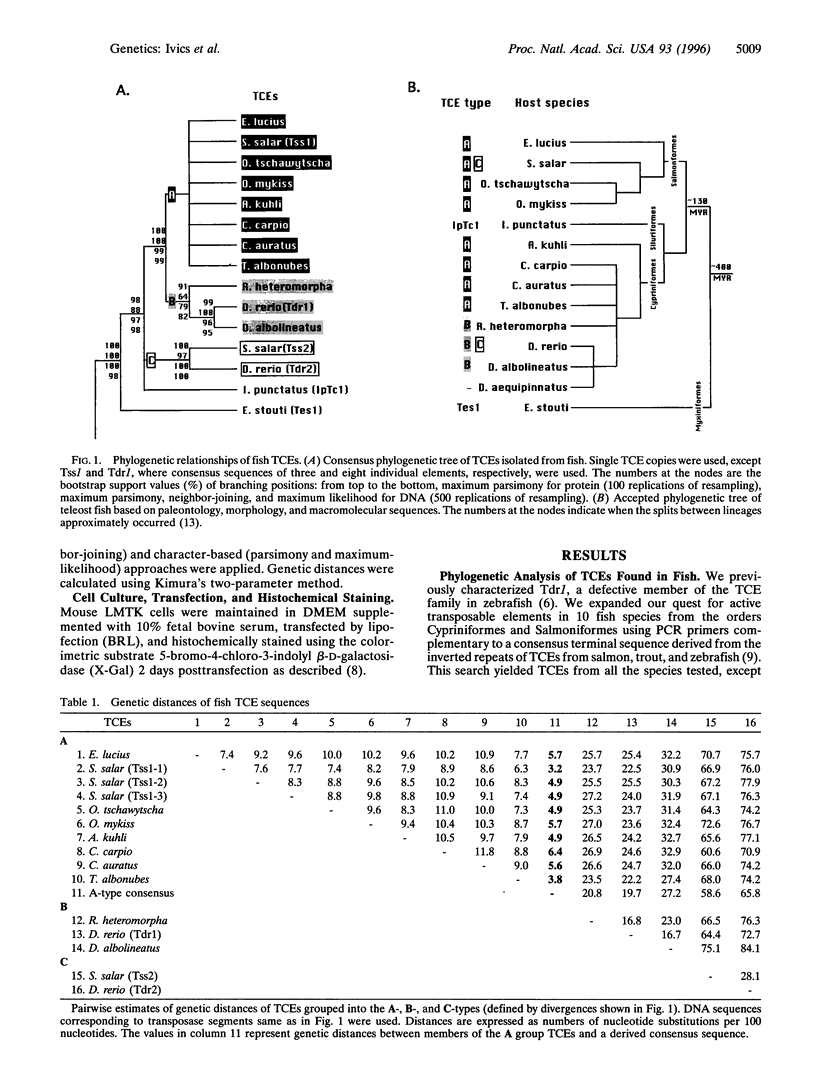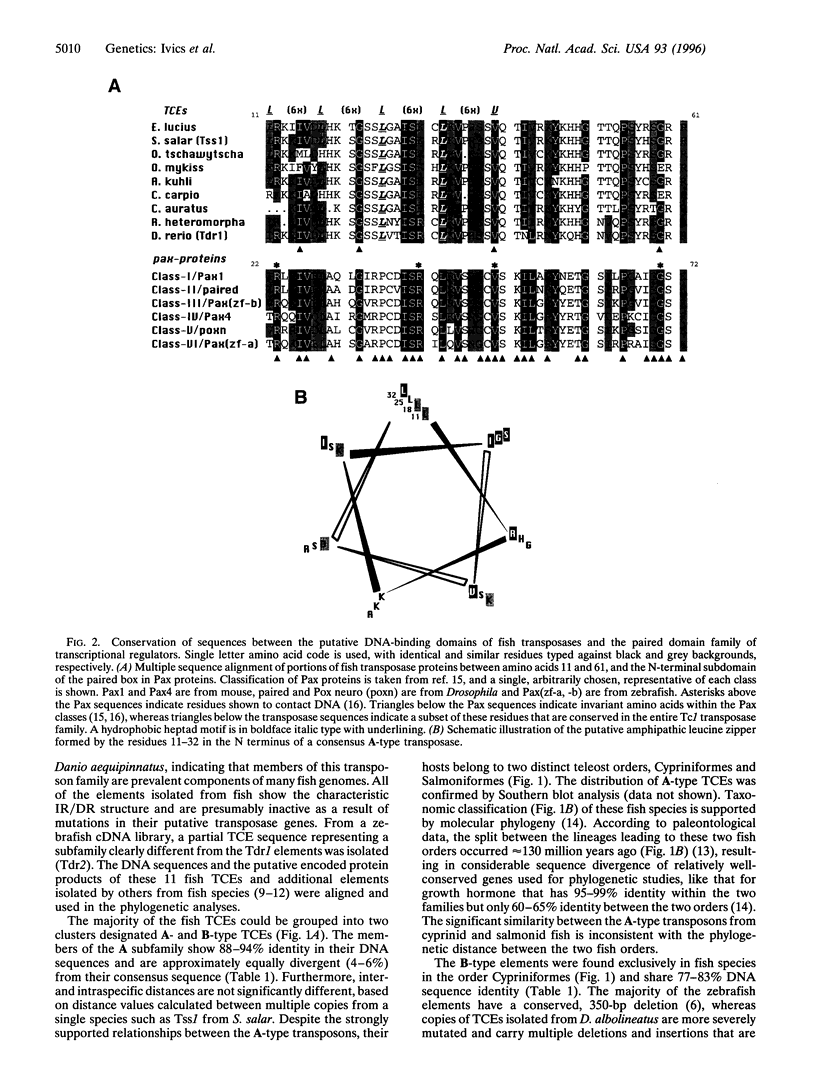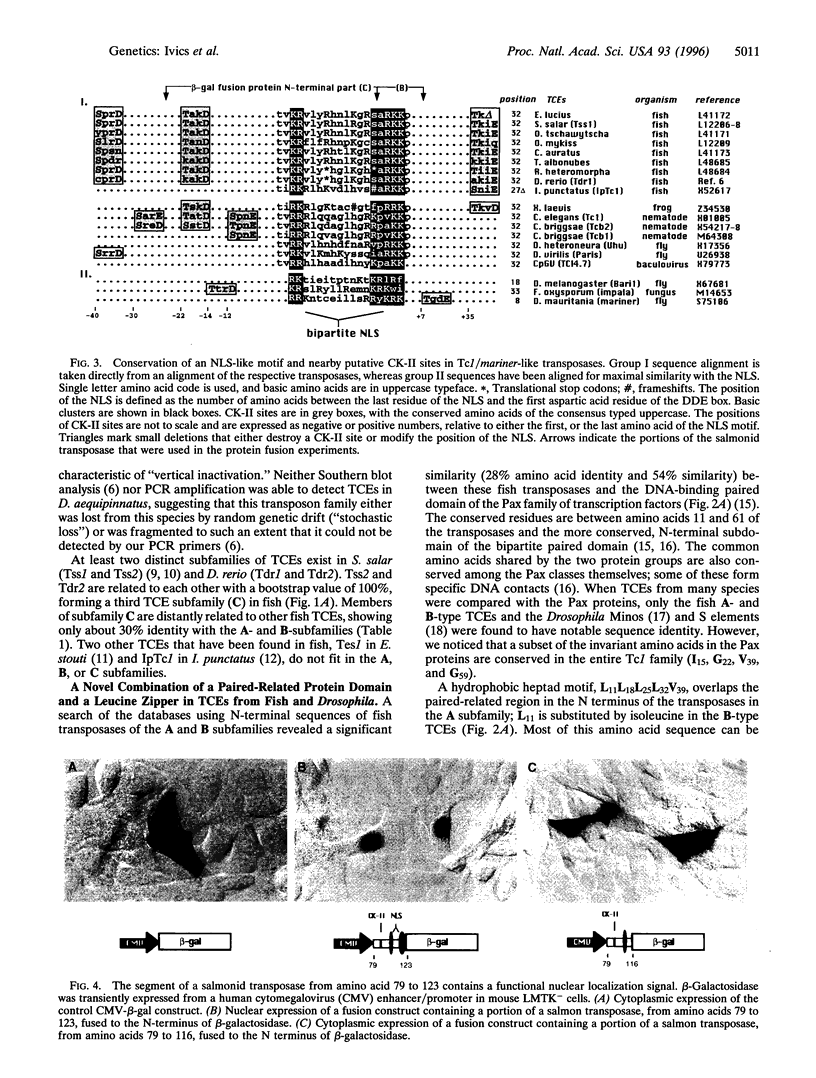Abstract
Tc1-like transposable elements from teleost fish have been phylogenetically examined to determine the mechanisms involved in their evolution and conserved domains of function. We identified two new functional domains in these elements. The first is a bipartite nuclear localization signal, indicating that transposons can take advantage of the transport machinery of host cells for nuclear uptake of their transposases. The second is a novel combination of a paired domain-related protein motif juxtaposed to a leucine zipper-like domain located in the putative DNA-binding regions of the transposases. This domain coexists with a special inverted repeat structure in certain transposons in such phylogenetically distant hosts as fish and insects. Our data indicate that reassortment of functional domains and horizontal transmission between species are involved in the formation and spread of new types of transposable elements.
Full text
PDF





Images in this article
Selected References
These references are in PubMed. This may not be the complete list of references from this article.
- Baxevanis A. D., Vinson C. R. Interactions of coiled coils in transcription factors: where is the specificity? Curr Opin Genet Dev. 1993 Apr;3(2):278–285. doi: 10.1016/0959-437x(93)90035-n. [DOI] [PubMed] [Google Scholar]
- Bernardi G., D'Onofrio G., Caccio S., Bernardi G. Molecular phylogeny of bony fishes, based on the amino acid sequence of the growth hormone. J Mol Evol. 1993 Dec;37(6):644–649. doi: 10.1007/BF00182750. [DOI] [PubMed] [Google Scholar]
- Bukrinsky M. I., Haggerty S., Dempsey M. P., Sharova N., Adzhubel A., Spitz L., Lewis P., Goldfarb D., Emerman M., Stevenson M. A nuclear localization signal within HIV-1 matrix protein that governs infection of non-dividing cells. Nature. 1993 Oct 14;365(6447):666–669. doi: 10.1038/365666a0. [DOI] [PMC free article] [PubMed] [Google Scholar]
- Capy P., Anxolabéhère D., Langin T. The strange phylogenies of transposable elements: are horizontal transfers the only explantation? Trends Genet. 1994 Jan;10(1):7–12. doi: 10.1016/0168-9525(94)90012-4. [DOI] [PubMed] [Google Scholar]
- Colloms S. D., van Luenen H. G., Plasterk R. H. DNA binding activities of the Caenorhabditis elegans Tc3 transposase. Nucleic Acids Res. 1994 Dec 25;22(25):5548–5554. doi: 10.1093/nar/22.25.5548. [DOI] [PMC free article] [PubMed] [Google Scholar]
- Craig N. L. Unity in transposition reactions. Science. 1995 Oct 13;270(5234):253–254. doi: 10.1126/science.270.5234.253. [DOI] [PubMed] [Google Scholar]
- Dingwall C., Laskey R. A. Nuclear targeting sequences--a consensus? Trends Biochem Sci. 1991 Dec;16(12):478–481. doi: 10.1016/0968-0004(91)90184-w. [DOI] [PubMed] [Google Scholar]
- Doak T. G., Doerder F. P., Jahn C. L., Herrick G. A proposed superfamily of transposase genes: transposon-like elements in ciliated protozoa and a common "D35E" motif. Proc Natl Acad Sci U S A. 1994 Feb 1;91(3):942–946. doi: 10.1073/pnas.91.3.942. [DOI] [PMC free article] [PubMed] [Google Scholar]
- Franz G., Loukeris T. G., Dialektaki G., Thompson C. R., Savakis C. Mobile Minos elements from Drosophila hydei encode a two-exon transposase with similarity to the paired DNA-binding domain. Proc Natl Acad Sci U S A. 1994 May 24;91(11):4746–4750. doi: 10.1073/pnas.91.11.4746. [DOI] [PMC free article] [PubMed] [Google Scholar]
- Goodier J. L., Davidson W. S. Tc1 transposon-like sequences are widely distributed in salmonids. J Mol Biol. 1994 Aug 5;241(1):26–34. doi: 10.1006/jmbi.1994.1470. [DOI] [PubMed] [Google Scholar]
- Heierhorst J., Lederis K., Richter D. Presence of a member of the Tc1-like transposon family from nematodes and Drosophila within the vasotocin gene of a primitive vertebrate, the Pacific hagfish Eptatretus stouti. Proc Natl Acad Sci U S A. 1992 Aug 1;89(15):6798–6802. doi: 10.1073/pnas.89.15.6798. [DOI] [PMC free article] [PubMed] [Google Scholar]
- Izsvák Z., Ivics Z., Hackett P. B. Characterization of a Tc1-like transposable element in zebrafish (Danio rerio). Mol Gen Genet. 1995 May 10;247(3):312–322. doi: 10.1007/BF00293199. [DOI] [PubMed] [Google Scholar]
- Jehle J. A., Fritsch E., Nickel A., Huber J., Backhaus H. TCl4.7: a novel lepidopteran transposon found in Cydia pomonella granulosis virus. Virology. 1995 Mar 10;207(2):369–379. doi: 10.1006/viro.1995.1096. [DOI] [PubMed] [Google Scholar]
- Langin T., Capy P., Daboussi M. J. The transposable element impala, a fungal member of the Tc1-mariner superfamily. Mol Gen Genet. 1995 Jan 6;246(1):19–28. doi: 10.1007/BF00290129. [DOI] [PubMed] [Google Scholar]
- Levy A. A., Walbot V. Regulation of the timing of transposable element excision during maize development. Science. 1990 Jun 22;248(4962):1534–1537. doi: 10.1126/science.2163107. [DOI] [PubMed] [Google Scholar]
- Lohe A. R., Moriyama E. N., Lidholm D. A., Hartl D. L. Horizontal transmission, vertical inactivation, and stochastic loss of mariner-like transposable elements. Mol Biol Evol. 1995 Jan;12(1):62–72. doi: 10.1093/oxfordjournals.molbev.a040191. [DOI] [PubMed] [Google Scholar]
- Merriman P. J., Grimes C. D., Ambroziak J., Hackett D. A., Skinner P., Simmons M. J. S elements: a family of Tc1-like transposons in the genome of Drosophila melanogaster. Genetics. 1995 Dec;141(4):1425–1438. doi: 10.1093/genetics/141.4.1425. [DOI] [PMC free article] [PubMed] [Google Scholar]
- Mikaélian I., Drouet E., Marechal V., Denoyel G., Nicolas J. C., Sergeant A. The DNA-binding domain of two bZIP transcription factors, the Epstein-Barr virus switch gene product EB1 and Jun, is a bipartite nuclear targeting sequence. J Virol. 1993 Feb;67(2):734–742. doi: 10.1128/jvi.67.2.734-742.1993. [DOI] [PMC free article] [PubMed] [Google Scholar]
- Petrov D. A., Schutzman J. L., Hartl D. L., Lozovskaya E. R. Diverse transposable elements are mobilized in hybrid dysgenesis in Drosophila virilis. Proc Natl Acad Sci U S A. 1995 Aug 15;92(17):8050–8054. doi: 10.1073/pnas.92.17.8050. [DOI] [PMC free article] [PubMed] [Google Scholar]
- Radice A. D., Bugaj B., Fitch D. H., Emmons S. W. Widespread occurrence of the Tc1 transposon family: Tc1-like transposons from teleost fish. Mol Gen Genet. 1994 Sep 28;244(6):606–612. doi: 10.1007/BF00282750. [DOI] [PubMed] [Google Scholar]
- Rihs H. P., Jans D. A., Fan H., Peters R. The rate of nuclear cytoplasmic protein transport is determined by the casein kinase II site flanking the nuclear localization sequence of the SV40 T-antigen. EMBO J. 1991 Mar;10(3):633–639. doi: 10.1002/j.1460-2075.1991.tb07991.x. [DOI] [PMC free article] [PubMed] [Google Scholar]
- Vos J. C., Plasterk R. H. Tc1 transposase of Caenorhabditis elegans is an endonuclease with a bipartite DNA binding domain. EMBO J. 1994 Dec 15;13(24):6125–6132. doi: 10.1002/j.1460-2075.1994.tb06959.x. [DOI] [PMC free article] [PubMed] [Google Scholar]
- Walther C., Guenet J. L., Simon D., Deutsch U., Jostes B., Goulding M. D., Plachov D., Balling R., Gruss P. Pax: a murine multigene family of paired box-containing genes. Genomics. 1991 Oct;11(2):424–434. doi: 10.1016/0888-7543(91)90151-4. [DOI] [PubMed] [Google Scholar]
- Wilson M. R., Marcuz A., van Ginkel F., Miller N. W., Clem L. W., Middleton D., Warr G. W. The immunoglobulin M heavy chain constant region gene of the channel catfish, Ictalurus punctatus: an unusual mRNA splice pattern produces the membrane form of the molecule. Nucleic Acids Res. 1990 Sep 11;18(17):5227–5233. doi: 10.1093/nar/18.17.5227. [DOI] [PMC free article] [PubMed] [Google Scholar]
- Xu W., Rould M. A., Jun S., Desplan C., Pabo C. O. Crystal structure of a paired domain-DNA complex at 2.5 A resolution reveals structural basis for Pax developmental mutations. Cell. 1995 Feb 24;80(4):639–650. doi: 10.1016/0092-8674(95)90518-9. [DOI] [PubMed] [Google Scholar]
- van Luenen H. G., Colloms S. D., Plasterk R. H. The mechanism of transposition of Tc3 in C. elegans. Cell. 1994 Oct 21;79(2):293–301. doi: 10.1016/0092-8674(94)90198-8. [DOI] [PubMed] [Google Scholar]







